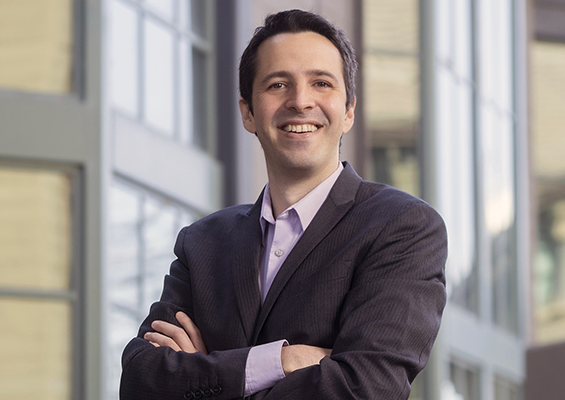First and foremost a behavioral economist, Ricardo Perez-Truglia, PhD, is happiest when the “common sense” concepts he teaches in Microeconomics influence the decisions made by his students in the Evening & Weekend MBA and MBA for Executives programs, whether they are in the office or at the grocery store.
Named a Sloan Research Fellow in 2020—an award given by the Alfred P. Sloan Foundation to stimulate fundamental research by early-career scientists and scholars of outstanding promise—Perez-Truglia focuses his research on the intersection of behavioral economics, political economy, and public economics. Recent publications have explored the effects of salary comparisons and salary transparency, and an unusual approach to studying the gender pay gap.
What do you hope students will take away from your core Microeconomics class?
My most important goal is that students learn a way of thinking.
Microeconomics should not be about memorizing formulas and ‘econo-slang’ terms like opportunity cost or market equilibrium. Of course, we talk about those things, but we do it in the context of using common sense, logic, and data to make decisions. In the end, Micro is about critical thinking.
Not long ago, a former student told me that when she was at the supermarket buying groceries, she looked at the prices and products and she couldn’t stop thinking about our classroom discussions. Jokingly, she said, it was like I was inside her head. I love that my class changes the way students look at the world and make decisions. That is exactly what I’m aiming for.
What is a favorite classroom exercise or assignment?
I try to flip the classroom. Rather than lecturing, I ask students to watch asynchronous videos on various topics and frameworks ahead of class. When we gather in the classroom, we hit the ground running with discussions and group activities. The active learning happens in the classroom, by applying the concepts.
What I enjoy most about teaching is when we apply abstract concepts to very practical situations that they may be reading about in the newspapers or encountering on the job or in their daily lives.
For example, to teach about market equilibrium, I might ask the simple question “What’s going to happen to the price of bitcoin?” Working in small groups, they apply the market equilibrium model to this question and then share their insights. The groups tend to come up with different answers. That is appropriate, given that the correct answer for almost any microeconomic question is “It depends.”
How would you describe Haas MBA students?
I am always struck by how much people care about others and how much they care about having rewarding jobs, personally, but also for the larger society.
Early in each term, I ask the question: “What makes a firm valuable?” In economics, there is one concrete answer. A firm’s value is based on its ability to make profits now and into the future.
Haas students, however, typically offer a myriad of answers. They want to take into account a firm’s contributions to the environment, to the community, to equity. I’m super happy about that. We have meaningful, thoughtful conversations about things you might not expect in a Micro class: the gender pay gap, minimum wage, rent control, antitrust, how market power affects consumers.
Haas students are not the cartoon MBAs who only want to make more money. They also want to be good parents, good to others, good voters. I relate to them, and that makes teaching my class all the more rewarding and enjoyable.
Your research explores some of those concepts. How do you connect your research to the classroom?
One of my research topics is the gender pay gap. In my Micro class, we do an exercise on the topic. The exercise uses data that relates to the students directly: the earnings after graduating from an MBA. The data shows that female MBAs earn almost the same as male MBAs immediately after graduation. When I ask students what they think the pay differential is 15 years later, they typically estimate that female MBAs earn between 10 and 20% less than male MBAs. It actually is closer to 50%. We talk about how societal and workplace norms—women staying home to raise children, male workers socializing with male managers—combine to frustrate the progression of talented female workers.
I also study salary transparency. The students relate a lot to this topic, especially when they negotiate their salary or have to decide whether to change jobs. There is a lot we can learn about transparency policies in other countries. For example, Norway has had salary transparency for decades. You could look up anyone’s salary, but you had to go to the tax office and page through big books. Now, however, the internet has made the data so much more accessible. I want to understand the implications of these transparency policies, positive and negative, intended and unintended. We are beginning to understand that transparency is not an off/on switch. You need to think about how much to disclose and how you do it: Aggregated or dis-aggregated? How do you give people the information they need to make decisions, without damaging people’s feelings of self-worth? We need to maximize the benefit and minimize the harm.
What new course would you design for the MBA curriculum?
It would be cool to teach an elective in behavioral economics. I would introduce the basic principles of behavioral economics, to help students recognize the biases that lead to poor decision-making.
It is well-documented that individuals tend to make large, systematic mistakes in making important decisions, like choosing a health care plan or deciding how much to save for retirement. What hasn’t been as well scrutinized is how companies, even big firms, make very, very big mistakes. After all, a firm doesn’t decide; individuals working there decide—humans who are prone to error. And when big companies make mistakes, the consequences ripple out to consumers, employees, and their families. I think that the insights from behavioral economics could help students to avoid those kinds of mistakes.
The class also would be a good excuse to teach students more about the scientific method. These days companies are more and more open to running experiments to find out what works and what doesn’t. Learning how to design a good experiment is a skill that can create a lot of value.
The expertise and insight your professors bring helps deepen and enhance your MBA journey. By selecting a top school with top-notch professors, you maximize your experience.
Read more from the Take 5 with a professor series:
- Sean Foote scores in venture capital and private equity and in the classroom
- Jon Metzler connects people and places in ways that foster innovation
- Homa Bahrami explores agility and flexibility for enterprises and individuals
- Cameron Anderson can prove that being a jerk is not a good career strategy
- Laura Kray reveals the skill MBAs want in their core curriculum
- Kellie McElhaney talks equity fluency, courage, and vulnerability
- Lucas Davis shares hardest economic concept for MBA students to grasp
- Jenny Chatman gives three benchmarks of an effective organizational culture
- Jennifer Cohen talks equitable and inclusive leadership
- Clark Kellogg shares how he teaches design thinking, creativity, and innovation
- Dave Rochlin talks flipping the classroom: MBAs learn by doing
- Maura O'Neill says narrow-mindedness is the enemy of innovation
- Bill Pearce says most important trait of a successful marketer is empathy









